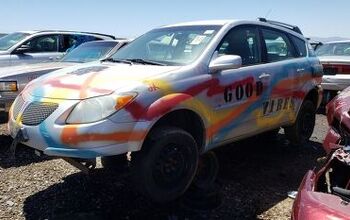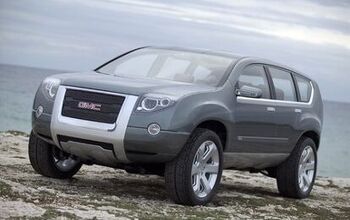General Motors Death Watch 98: The Last Redoubt
Has anyone noticed that Toyota’s new pickup truck production plant is located in the same Texas town as The Alamo? I know: metaphorically speaking, it’s not a perfect fit. The Alamo has come to symbolize the spirit of any small group of believers holding out against overwhelming odds. In that sense, it should be Texas-built domestics pickups facing Mexican-built Toyota Tundras. Only Toyota is the little guy in this battle. Well, sort of. Anyway, no matter how you look at it, this whole pickup truck thing is shaping-up to be a Texas-sized brawl, and anyone who discounts ToMoCo’s chances (so to speak) is making a big mistake.
The perceived wisdom says Toyota’s Texas Tundra faces insurmountable odds. Last year, The Big Two Point Five carved-up 90 percent of the market. We’re talking 2.25m full-size pickups split between GM (935k), Ford (901k) and Dodge (414k). Thanks to rising gas prices and a falling construction market, ’06 pickup truck sales have taken a big hit. But the segment still generates enormous, life-sustaining profits. No wonder GM CEO Rabid Rick Wagoner publicly declared that his company’s fortunes rest squarely on the broad shoulders of the new Chevy Silverado and GMC Sierra. In short, there’s everything to play for.
Ho-hum. The domestics may not be smug about ToMoCo’s revised entry, but it sure sounds that way. According to an article in yesterday’s Detroit News (DTN), GM Car Czar “Maximum” Bob Lutz doesn’t think his company’s full-size pickups are anywhere near crap enough to lose out to the new Tundra. “Lutz said when Japanese automakers grabbed significant share in the U.S. car market between 1979 and 1981, Toyota and Honda Motor Co. were building better quality vehicles.” Setting aside any debate about the beginning and end points of Maximum Bob’s time line, we can extrapolate his main point: we’re ready. Bring it on.
Fair enough. GM, Ford and Dodge make some mighty fine pickups. As MB said, this is not a case where domestic abuse has thrown open the window of opportunity for higher quality competitors to defenestrate the established players. Pickup truck buyers are also notoriously brand loyal. And if you believe the media, they’re all a bunch of NASCAR-loving red staters (not to say rednecks) who’d rather trade their Budweiser beer for a charming little chardonnay than not buy a gen-u-ine ‘Merican pickup. If ever a market segment was well-defended, this is it.
Yes, well, this time out, Toyota’s not bringing a knife to a gun fight. The '07 Tundra is bigger, tougher-looking and more capable than its predecessor, from its industrial strength air conditioner to its promised "class leading" towing capacity. And Toyota’s going in with their eyes open: "We've been competing with Ford, GM and Dodge for 50 years," Toyota PR flack Denise Morrissey told the DTN. "We know the full-size market is very loyal and smart. Once they get familiar with the Tundra, get to know it, I think they will consider it. Loyalty is definitely key in this market, but it will only get you so far."
If Detroit was paying attention, that little comment would give them major cause for concern. Morrissey is saying that Motown’s pickup buyers aren’t as loyal as the domestics would have themselves believe. While Lutz and his cohorts are right to insist that their products are good enough to withstand a side-by-side comparison with the new Tundra, Toyota is smart enough to know it only has to meet– not beat– the domestic pickups’ capabilities. It can then deploy a secret weapon which will seduce great swathes of brand faithful pickup truck buyers, and carve out an enormous chunk of this vastly profitable market: price.
The GM Silverado starts at $27k. The Dodge Ram starts at $22,135. The Ford F-150 starts at $18,220. The current Toyota Tundra starts at $16,155. While we’d have to turn to Michael Karesh for a proper price comparison, the relative disparity indicated by these numbers is not misleading. Lest we forget, Toyota is a non-union manufacturer without excessive legacy costs and excess production capacity, that’s building its new pickup in a brand spanking new (i.e. extremely efficient) facility. What’s more, pickups trucks are relatively cheap to build and Toyota has plenty of money in the bank.
So, if Toyota builds a competitive product, they’re perfectly positioned to attack domestic pickups on price. Remember: the majority of pickups sold are work trucks. As such, their owners are hardly immune to economic arguments for a different brand; it’s “I’m a businessman” first, “I’m a Chevy guy” second. Toyota says it wants its sell 200k ’07 Tundras. To do that, they’ll have to compete on price– which will put irresistible pressure on The Big 2.5 to cut their margins. Even without capturing significant market share, Toyota’s overwhelming economic force could threaten GM’s survival. Think it couldn’t happen? Remember the Alamo.
More by Robert Farago
Latest Car Reviews
Read moreLatest Product Reviews
Read moreRecent Comments
- Fed65767768 Good Christ, no.CP.
- Kwik_Shift_Pro4X The main advice I've heard is to stay away from the BMW engine.
- Rna65689660 For Los Angeles, this is super cheap housing. For it surely will be not going anywhere very often. Park it at Wallyworld for 3 days, then move to the next lot.
- MaintenanceCosts This is half a car, because half the time it will be in the shop.
- Mm3 ^^^ Sounds like a bunch of dudes who have never owned a Land Rover/Range Rover

































Comments
Join the conversation
"Well, it couldn’t be ‘antiquated’ as no one else has ever done it. ‘Primitive’ also gives it a timeline perspective that simply doesn’t exist." - Kaisen No, the more I think about it, "primitive" is the word. I could shut off the motor in my 5-speed vehicle, coast to a light and restart just in time to take off. That's all the BAS handles. And any discussion of whether or not a "timeline perspective" exists should take into account the fact that the Escape Hybrid, Prius, Accord and Insight have been available for years.
The BAS does more than shut the motor off and restart it. Acting as a motor, the BAS also briefly provides up to 110lb-ft of torque assist to the gas engine during acceleration (one of the reasons the Greenline accelerates to 60 one second faster than the gas 4cyl). Acting as a alternator/generator, the BAS provides up to 3000 watts (3 kilowatts) of continous power. Acting as a starter, the 42V BAS is much more efficient than the 12V gear-drive brush/stator starter in your car, and can silently (and smoothly) start the gas engine as quickly as you lift your foot from the brake and move it to the gas pedal. The nickel-metal-hydride (NiMh)batteries are there for a reason too, providing 10,000 watts of reserve to run all electrical systems such as headlights and HVAC when the engine is off. It may be simple, but it is not primitive. And any discussion of timeline should include the GM/Saturn EV1 electric car which preceded the Prius by several years.